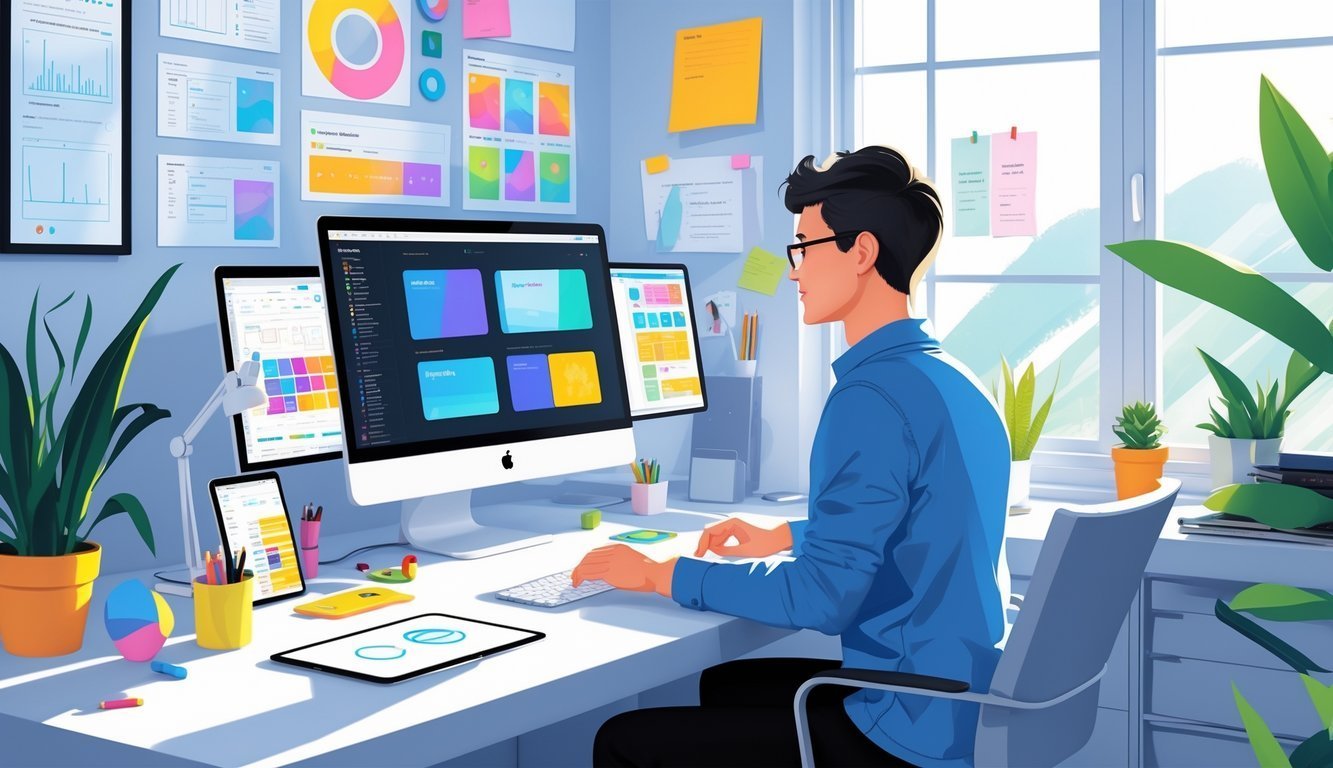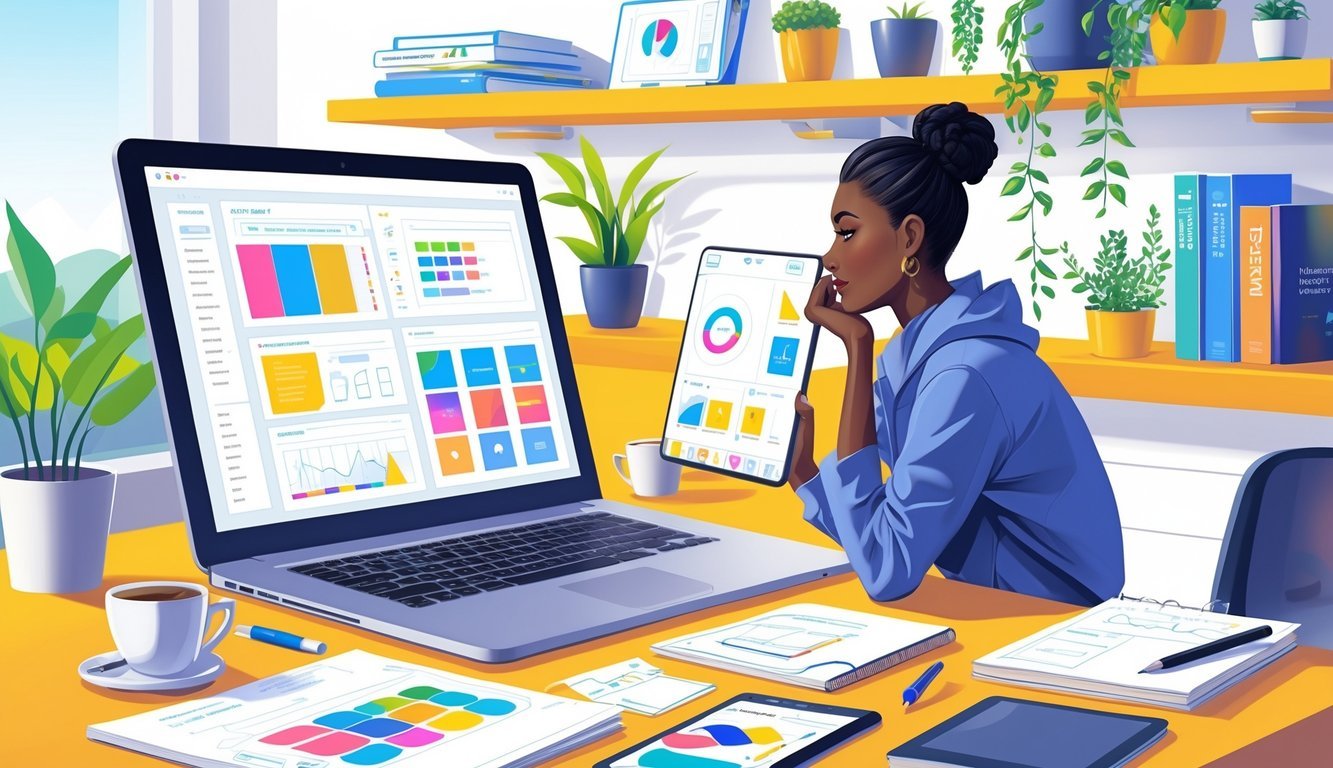PsychNewsDaily Publishers
100 Summit Drive
Burlington, MA, 01803
Telephone: (320) 349-2484
PsychNewsDaily Publishers
100 Summit Drive
Burlington, MA, 01803
Telephone: (320) 349-2484
Freelance UX/UI design offers flexibility, creative control, and diverse projects, requiring strong communication skills, a solid portfolio, and effective client management for success.

Freelance UX/UI design is a field that keeps growing. You get to work on projects for all kinds of clients, and you set your own schedule. If you’re looking for flexibility and want more creative control, freelance UX/UI design gives you the freedom to shape your career however you like—often from anywhere you want.
A lot of designers pick freelancing because they want more variety in their work and a say in how they balance their time.
When you start out as a freelance UX/UI designer, you’ll need to figure out how to find clients, build a solid portfolio, and market yourself. Most of the time, you’ll connect with companies and startups online since remote work is so common.
It really helps to have good communication skills and to pay attention to what clients want.
Maybe you’re leaving a traditional job, or maybe you’re just getting started. Either way, freelancing gives you ways to grow your skills and your income.
If you stick with it, you can build up a steady stream of clients and turn UX/UI design into a career that actually lasts.

When you start freelancing in UX/UI, you have to know what the roles actually mean and how freelancing is different from a regular job.
You’ll also want to build up a few key skills to do well on your own. Understanding these basics can give you a more confident start.
UX design is all about how users feel when they use a product. You want things to be smooth, easy, and actually helpful.
You’ll think about user flows, wireframes, and run usability tests.
UI design, on the other hand, is about how everything looks. You’ll design buttons, menus, colors, and fonts to make the interface clear and nice to look at.
UI work keeps everything visually consistent and appealing.
A lot of freelancers do both UX and UI. You end up handling both how a product works and how it looks.
You might work on websites, apps, or just about any digital product.
When you freelance, you run your own schedule and pick your own projects.
You’re in charge of finding clients, writing contracts, and setting your own rates. Nobody’s going to tell you what to do each day.
Full-time jobs usually have set hours and a steady paycheck. Freelance income can swing up and down, so you have to be okay with some uncertainty.
You also need to manage your time well.
Clients usually want fast replies and solid work. You’ll probably juggle a few projects at once, so staying organized really matters.
You need design skills, but you also need communication skills.
Listening to clients and explaining your ideas clearly helps avoid mistakes and keeps projects moving.
You should know tools like Figma, Sketch, or Adobe XD to create your designs. If you know some and CSS, that’s a bonus for working with developers.
Marketing yourself is a big part of freelancing. Build a portfolio that shows off your work and keep it updated.
Networking and joining freelance platforms can help you find gigs.
Learning to manage your time and money will help your freelance business run smoother.
These skills make things less stressful and a lot more professional.

If you want to grow your freelance UX/UI career, you need to show your best work, pick the right job platforms, communicate well, and use the right tools.
These steps really help you land jobs, manage projects, and build a reputation.
Your portfolio is what gets you noticed. Show off your best UX and UI projects, and don’t just post the final designs.
Add case studies that walk through your process, like wireframing, user research, and prototyping. Explain what you did and how your work solved problems.
Platforms like Dribbble and Behance help you put your portfolio in front of clients. Hiring managers often browse these sites looking for freelance designers.
Keep your portfolio clean and updated. A well-organized portfolio makes it easy for clients to see your skills right away.
You’ll find freelance UX/UI jobs on sites like Upwork, Fiverr, PeoplePerHour, and Toptal.
Each platform has its own system. On Upwork and PeoplePerHour, you send proposals after clients post jobs.
On Fiverr, you set up “gigs” that clients can buy directly.
Toptal is more selective—they vet you first—but you might get higher-paying gigs there.
LinkedIn is also great for networking and letting people know you’re available.
Pick platforms that fit your style and experience. Make sure your profiles look professional and include the details clients care about.
Clear communication keeps your projects running smoothly and your clients happy.
Use simple language when you talk about project needs and expectations.
Video calls help build trust and clear up questions fast. Take notes during meetings so you don’t miss anything.
Project management tools like Trello, Asana, or Notion help you stay organized.
Give clients regular updates. Share prototypes and designs as you go so you can get feedback early.
Good communication means fewer revisions and a faster, less painful hiring process.
You need good tools to do your job well and stay organized. Figma is a favorite for wireframing, design, and prototyping, especially if you’re working remotely with others.
Adobe Illustrator is great for more detailed graphics and UI elements.
Use research and information architecture tools to really understand your users.
Behance Pro lets you show off your work in a polished way.
Mix design tools with project management and communication apps so you don’t get swamped with admin stuff.
Having the right software saves time and makes your freelance work better.

Starting as a freelance UX/UI designer means you’ll need to know where to find jobs and how to build up your skills and portfolio.
You’ll also want to figure out your rates and how long it takes to get really good at this.
Start by learning the basics of UX/UI design—online courses or bootcamps are good options.
Build a portfolio with personal or volunteer projects. Join design communities and pitch small projects to get your foot in the door.
Show your design process. Add sketches, wireframes, and finished designs.
Use projects that solve real problems, even if you make them up for practice. Keep your portfolio easy to navigate and put your best work front and center.
Rates depend on your experience and where you live. If you’re just starting, you might charge $20 to $40 an hour.
More experienced designers often go for $50 to $100+ per hour. As you get better and build up reviews, you can raise your rates.
Check sites like Upwork, Fiverr, and Freelancer. Try job boards like Dribbble or Behance too.
Networking in online design groups sometimes leads to remote gigs.
They set up clear, professional profiles and show off a strong portfolio.
They write custom proposals for each job instead of copy-pasting. Building good relationships and asking happy clients for reviews helps bring in more work over time.
You can definitely pick up the basics of UX design in three months, as long as you stick with regular practice. Of course, becoming truly skilled takes a lot more time and hands-on experience.
Try to dive into user research and wireframing right from the start. Those skills really make a difference early on.